The Role of Refractometer Index in Gemology
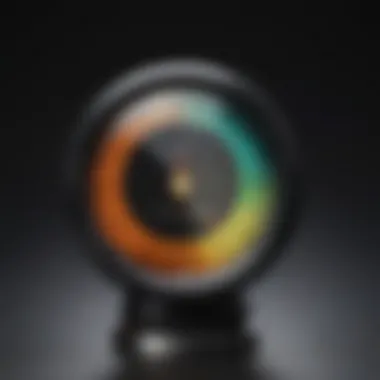
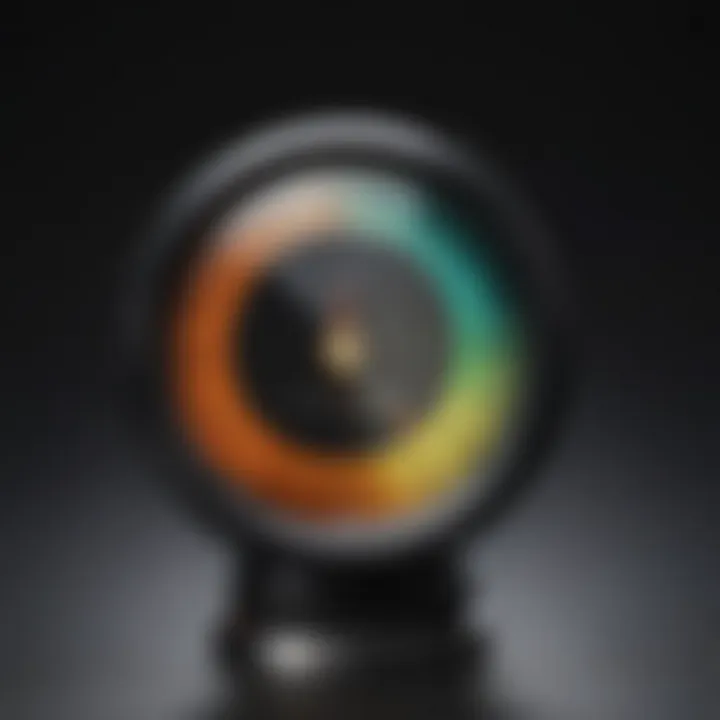
Intro
In the colorful world of gemstones, where beauty often dances with mystery, the refractometer index emerges as a vital key. This instrument doesn’t just sit on a shelf; it forms the backbone of gemology. By measuring how light bends, we can glean vital information about gemstones—what they are, their quality, and how they fit within the larger mosaic of minerals. In this article, we’ll embark on a journey that blends science and art, uncovering how the refractometer plays a crucial role in gem identification and valuation.
Gemstone Overview
Definition of Gemstones
Gemstones are more than pretty stones; they are natural minerals, some refined and others raw, that have crystal structures, making them suitable for use in jewelry and ornamentation. Defined by their luster, clarity, and hue, each gemstone is unique. Most commonly, we discover them through mining or fishing—think Opal from Australia or Emerald from Colombia—but, they can also be produced synthetically.
Classification of Gemstones
Understanding gemstones often hinges on their classification. Broadly, we can group them into two categories:
- Precious Gemstones: Such as diamonds, rubies, sapphires, and emeralds. These gems have traditionally held higher value due to their rarity and desirability.
- Semi-Precious Gemstones: Think amethyst, garnet, and turquoise. While these stones aren’t as rare and valued comparatively, they still possess distinct beauty and appeal.
The Role of Refractive Indices
Here’s where the refractometer index comes into play. Each gemstone has a unique refractive index, a specific value indicating how light bends when it enters and exits the stone. Jewelers, gemologists, and enthusiasts alike rely on refractive indices to confirm identities and authenticate gemstones.
Historical Significance
Origins of Gemstone Use
Gemstones have graced humanity since ancient times. Early civilizations adorned themselves with these natural luxuries, believing they held protective and healing properties. The Egyptians adorned their tombs with carnelian and lapis lazuli, while in the East, jade was cherished as a symbol of virtue and power.
Cultural Insights: Gemstones in Ancient Civilizations
Every culture has its lore wrapped around gemstones. The Heart of the Egyptian king, adorned with turquoise and lapis, served as a fashion statement and spiritual talisman. The Greeks associated sapphires with Apollo, believing they brought wisdom. To the Romans, there was no end to the beliefs surrounding emeralds, interpreting their vivid green as a representation of rebirth and renewal.
Gemstones are not only valued for their aesthetic appeal but also for their deeply rooted cultural significance across civilizations.
End
As we delve deeper into the refractometer index's applications, we begin to connect the dots between beauty and science, forming a clearer picture of what truly defines gemstones. Gaining a thorough understanding of the refractive index offers the gem enthusiast a pathway to appreciating these natural wonders not only for their visual characteristics but also for the intriguing science that underpins them.
Prelims to Refractometry
Understanding refractometry is crucial for anyone stepping into the captivating world of gemology. It serves as the backbone of gemstone identification and valuation. These methods enable gemologists and enthusiasts to quantify how light bends in various materials, providing insights on a gemstone’s authenticity and quality.
The refractive index, a key concept in this field, not only distinguishes one gem from another but also plays a significant role in determining their market value. Knowing how to measure and interpret these indices opens a Pandora's box of possibilities for evaluators and collectors alike. Moreover, it helps in distinguishing natural stones from synthetic or treated ones, which can be invaluable in preserving the integrity of the gem market.
Definition and Overview
Refractometry is the branch of science that deals with the measurement of the refractive index of materials. Essentially, it focuses on how light propagates through different substances. When light travels from one medium to another—such as from air to a gemstone—it changes speed, altering its direction in what’s termed refraction. This phenomenon is not just a scientific curiosity; it has practical applications that are critical for gemologists.
A refractometer is the instrument used for these measurements. By quantifying the angle at which light bends, a refractometer provides a precise numerical value known as the refractive index (RI). The RI is a dimensionless number and varies from one gemstone to another. For instance, diamond has a high RI of about 2.42, while quartz sits lower at approximately 1.54. Understanding these values can guide gem enthusiasts in assessing whether a stone is genuine or a synthetic substitute.
Historical Context
The journey of refractometry in gemology traces back to the early scientific explorations of light. The concept gained momentum in the 17th century, coinciding with the work of pioneers such as Willebrord Snellius and Christiaan Huygens. Their initial explorations into optics laid the groundwork for what would become a vital method in gemology.
As gems became more desirable and accessible, especially during the late Renaissance, more sophisticated techniques were demanded. The introduction of the first optical refractometer in the early 20th century marked a turning point. This apparatus simplified the measurement process, making it easier to distinguish high-quality gems from their lesser counterparts.
With advancements in technology, modern refractometers, including digital versions, have emerged, providing quicker and more accurate measurements. These innovations mean that gemologists today can have an edge in both quality assessment and market evaluation, ensuring that they stay ahead of the curve in an ever-evolving landscape.
"The refractive index serves not just as a measurement; it’s a gateway to understanding the very essence of gem materials."
These historical developments demonstrate how integral refractometry has become in gemology, guiding today’s practices and shaping the future of gemstone evaluation.
The Science of Refraction
The realm of gemology is steeped in fascinating layers of science, and one of its most essential components is the science of refraction. This aspect underpins our understanding of how light interacts with different materials and, consequently, how gems are examined and valued. Refraction plays a pivotal role in gemstone identification and quality evaluation, making it a cornerstone of gemological studies. If you want to appreciate the beauty and value of gemstones fully, a firm grasp of the principles of refraction is indispensable.
Principles of Light Refraction
Light refracts when it passes through different mediums. This bending of light occurs due to changes in speed as light crosses from one material to another, such as air into glass or water. The phenomenon is beautifully illustrated when you place a straw in a glass of water; the straw appears bent due to light refraction.
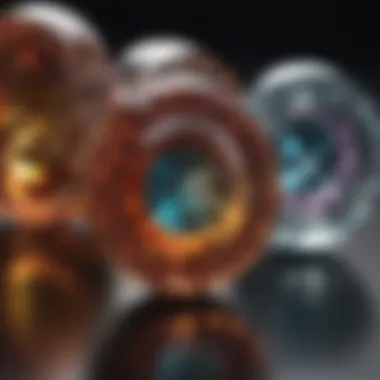
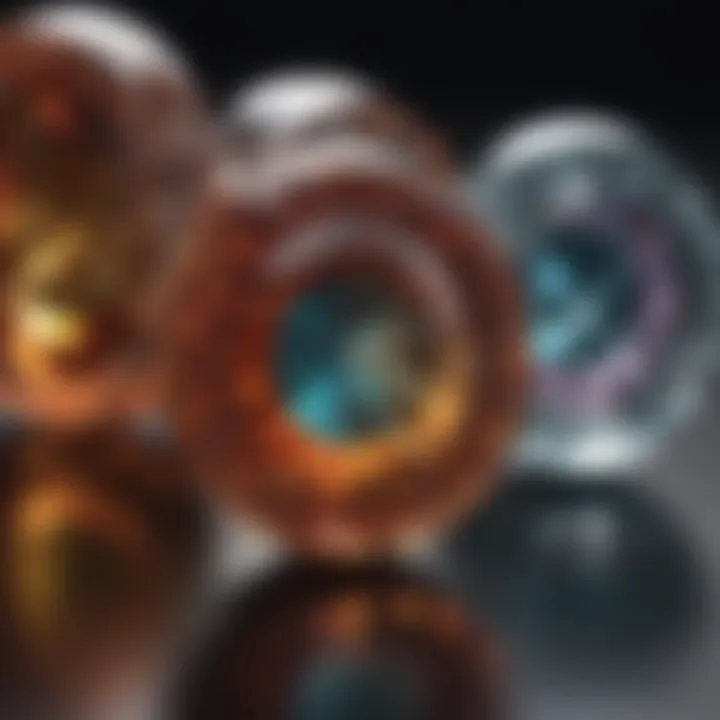
In gemology, each gemstone has a distinct refractive index, which measures how much light is bent when entering the stone. This index plays a critical role in gem identification, as it can differentiate between similar-looking stones.
Understanding the principles of light refraction not only assists in identifying gemstones but also aids in detecting any treatments or enhancements that may have been applied to the stones. Gems that reflect light uniquely may have undergone treatments, thus altering their natural refractive indices.
"The refractive index is where the magic begins, defining not just how a stone looks but how it interacts with light."
Understanding Refractive Index
Refractive index, abbreviated as RI, is a crucial concept in the world of gemstones. It refers to the ratio of the speed of light in a vacuum to the speed of light in the gemstone. For instance, a high refractive index means that light travels slow in the mineral, causing greater bending when entering or exiting the stone.
Each gem has its own RI value, which is essential for professionals in the field. Commonly, they use a scale to determine the RI of various stones:
- Diamond: 2.42
- Emerald: 1.57–1.60
- Amethyst: 1.54–1.55
These values help gemologists determine the type of stone they are dealing with. A quick measurement of the refractive index can assist in confirming the authenticity of a gem, thereby saving both time and money for collectors and jewelers alike.
Factors Affecting Refraction
Several factors can impact the way light refracts in gemstones, influencing their appearance and overall beauty. Some of these key factors include:
- Temperature: As the temperature changes, so does the refraction. A hotter stone may exhibit a different refractive index than when it's cool.
- Type of Light: Different wavelengths (colors) of light can bend at different angles. This can lead to variation in appearance depending on the light type, such as natural sunlight versus artificial lighting.
- Impurities and Inclusions: Various fractures, color inclusions, or impurities can alter the path of light as it travels through a gemstone, affecting its refractive index.
By understanding these factors, gemologists gain a comprehensive view of how a particular gemstone interacts with light. This knowledge is vital when assessing a gem's quality and potential value in the market.
Types of Refractometers
In gemology, refractometers serve as pivotal tools for identifying and appraising gemstones. The different types of refractometers each bring their own set of advantages and disadvantages, providing gem enthusiasts and professionals alike with choices that cater to specific needs. In this section, we'll explore the three prominent types: standard, digital, and portable refractometers. Each plays a unique role in the measurement of the refractive index, making it crucial to understand their individual functionalities.
Standard Refractometers
Standard refractometers are the classic models, often characterized by their optical components and mechanical operations. These instruments typically consist of a glass prism and a scale where users can read the refractive index directly. They work on basic principles of light and require a bit of skill to operate effectively. Here are some points of interest about standard refractometers:
- Cost-Effective: Generally, these devices are cheaper than their digital counterparts, making them accessible to hobbyists and small-scale gemologists.
- Reliability: As simple mechanical devices, they don't rely on batteries or electronics, which means less chance of malfunction in rough conditions.
- Calibration: Regular calibration is necessary to ensure accurate readings, and while it takes some effort, many find the process straightforward with practice.
However, users must be prepared to spend some time learning how to read measurements accurately and factoring in environmental conditions that may impact results.
Digital Refractometers
Digital refractometers represent a significant leap in technology. These instruments use electronic sensors to measure the refractive index, offering users enhanced precision and ease of use. The advantages of digital refractometers include:
- Ease of Use: With a simple push of a button, readings can be taken quickly and displayed on an LCD screen, making them particularly user-friendly.
- Data Storage: Many models offer the ability to store and recall previous measurements, enabling gemologists to keep good records without the hassle of manual note-taking.
- Advanced Features: Some digital refractometers come equipped with built-in temperature compensation, which helps in achieving more accurate results regardless of the testing environment.
Despite their benefits, the price point can be a hurdle for some, as digital models often come with a higher price tag. Additionally, like any electronic device, they may have a shorter lifespan due to potential wear and tear.
Portable Refractometers
For those constantly on the go, portable refractometers emerge as the ideal solution. These compact devices are designed for ease of transport while still being functional enough to provide accurate measurements. They can be either standard or digital in nature, but typically lean towards a more simplified design. Key highlights of portable refractometers include:
- Convenience: Small and lightweight, they fit easily into a pocket or gem tool kit, which is perfect for gem hunters or jewelers who travel to various locations.
- Speed: They often provide quick readings, enabling users to make rapid assessments in the field, which is crucial when time is of the essence.
- Versatility: Many portable refractometers are designed to be used on a range of materials, not just gemstones, expanding their utility.
Despite these advantages, users should keep in mind that portable refractometers may sacrifice some accuracy when compared to standard and digital models, especially when used in highly variable environmental conditions.
"A refractometer is more than a tool; it's a gateway to understanding the hidden beauty within gemstones. Choose wisely for your specific needs."
Understanding the distinctions among these types of refractometers is paramount for anyone serious about their work in gemology. Choosing the right one can make all the difference in obtaining accurate and useful results.
Measuring the Refractive Index
Understanding how to measure the refractive index is vital in gemology. This process provides essential insights not only into the nature of the gemstones but also about their potential value and authenticity. When a gemologist takes measurement readings, they can identify the material and assess its quality based on light behavior within it. Hence, this section will highlight the importance of precise measurement and how it connects to gemstone identification and their characteristics.
Calibration Procedures
Calibrating a refractometer is one of the bedrock procedures in ensuring accurate results. It’s like tuning a piano; if it’s not right, no matter how skilled you are, your performance may falter. To start, a refractometer should be calibrated against a known standard—usually distilled water or a specially prepared calibration fluid with a precise refractive index.
- Make sure the optical surfaces of the device are clean.
- Place a drop of the calibration fluid on the prism.
- Close the cover and look through the eyepiece.
- Adjust the calibration screw until the boundary line between light and dark aligns with the scale.
It’s a straightforward task but crucial for accuracy. A miscalibrated instrument can easily lead gemologists astray, interpreting an average diamond for a cubic zirconia, which can mean a world of difference in value.
Step-by-Step Measurement Process


Once calibration is set, the real work begins. Measuring the refractive index generally follows a controlled process to maintain consistency. Here’s a snapshot of the steps involved:
- Prepare the Sample: Always ensure the gemstone surface is clean and dry. Dirt or oil can skew results.
- Apply the Sample: Place a few drops of immersion oil on the prism. Then, place the gem onto it. The oil's refractive index should be close to that of the gemstone being tested.
- Close the Cover: Gently lower the cover over the sample to eliminate air bubbles.
- Observe Through the Eyepiece: Look through the eyepiece. You’ll see a shadow line, which is crucial in registering the index.
- Record the Reading: Align the shadow line with the scale and note the value. This refractive index will now guide your identification process.
Each step requires attention to detail. Missing one can lead to a miscalculated refractive index, leaving you scratching your head when you try to identify the gem.
Interpreting Results
Interpreting the gathered refractive index readings is where art blends with science. It’s crucial to understand the numbers in context.
- Comparison with Known Values: Most gemstones have a range of refractive index values that can be checked against references. For example, sapphires typically range from 1.76 to 1.77 while diamonds have a higher index around 2.42.
- Analyzing Variations: Slight differences can indicate treatments or enhancements the stone might have undergone. A reading lower than expected could hint at a synthetic alternative.
- Documenting Findings: Keeping a meticulous record of your findings can also illuminate patterns and assist in future identifications, especially for seasoned gemologists or enthusiastic collectors.
"Every gem has its own story, and understanding those stories begins with knowing the fundamental properties like refractive index."
Applications in Gemology
In the realm of gemology, the application of refractometer indices is paramount. The versatile use of refractometers enables gemologists to accurately identify gemstones, assess their quality, and ascertain treatment methods. Understanding how refractive properties play a role in these applications not only enhances the appreciation of gemstones but also solidifies their values in the market. This section succinctly delves into these critical applications, elucidating the techniques and insights gem enthusiasts can harness through refractometry.
Identifying Gemstones
Identifying gemstones can be as tricky as finding a needle in a haystack. Yet, the refractometer serves as a beacon of clarity. By measuring the refractive index, gemologists can narrow down the potential identity of gems significantly. Each gemstone possesses a unique refractive index, which acts like a fingerprint. For instance, sapphires and rubies share the same chemical composition, but their refractive indices lie within a narrow range, slightly favoring one over the other.
This precise measurement process not only aids in differentiation but also helps identify synthetics and imitations, which have become more common in today's market. For instance, while natural citrine may have a refractive index of around 1.54, some heat-treated amethyst can mimic this value closely. By assessing how light behaves in these stones, gemologists achieve a high level of accuracy in gemstone identification.
Evaluation of Gem Quality
The evaluation of gem quality is intertwined with the assessment of refractive indices. A higher-quality gemstone typically exhibits a desirable range of refractive indices, which correlates directly with its brilliance and glitter. For instance, diamonds, with a refractive index of about 2.42, radiate unmatched sparkle and shine. Understanding this correlation allows gemologists to provide a nuanced appraisal of a stone’s quality, facilitating informed buying and selling decisions.
Moreover, refractive indices can reveal the clarity and cut of a stone. For example, an improperly cut gem could show undesirable light dispersion, lowering its overall quality. Gem enthusiasts therefore come to appreciate not just the beauty but the intricate standards that underpin the value of the stones they covet.
Determining Gemstone Treatments
In a market bustling with treated gemstones, understanding treatment methods becomes all the more essential. Refractometry plays a critical role here as well. Some treatments enhance a gem’s color or clarity, while others may disguise flaws. Each of these methods can leave telltale signs in the refractive index profile.
For instance, when light passes through a stone that has been oil-treated to fill fractures, the refractive index may show a gradual change compared to a natural, untreated stone. This distinction offers gemologists a method to determine if a gemstone has been altered in any way, which can substantially impact its value and market authenticity.
"Understanding the refractive index is not just about numbers; it's about grasping the very essence of a gemstone's journey."
In summary, the various applications of refractometry in gemology unleash a treasure trove of information regarding gemstones. They empower enthusiasts, collectors, and professionals with tools to make informed decisions, thereby enhancing their appreciation for these natural wonders. Understanding these applications underscores the significance of refractive indices, transforming how we view and value gemstones in an ever-evolving market.
Refraction and Gemstone Value
Understanding the interplay between refraction and the value of gemstones is vital for any enthusiast or professional in gemology. The refractive index (RI) serves as a benchmark that helps in the appraisal and categorization of gems. As a gem enthusiast, knowing how these two concepts intertwine can sharpen your skills in gemstone identification and valuation.
The refractive index is not just a number; it provides insight into the gemstone’s density and composition. High RI values often indicate denser gemstones which tend to be more valuable. Each type of gemstone has its own characteristic RI range, which can significantly influence its market worth. This understanding allows gemologists and collectors to better gauge not only the authenticity of a stone but also its potential market price.
Moreover, an appreciation for refractive properties enables professionals to spot treatments or enhancements that can artificially inflate a stone's apparent value. For instance, synthetic materials or treated stones may mimic the external appearance of their natural counterparts but can have a vastly different refractive index. This discrepancy is crucial, as it reflects quality and can alert buyers to potential pitfalls.
In essence, the relationship between refraction and gemstone value includes:
- Identification: Knowing the refractive index helps in accurately identifying gemstones.
- Quality Evaluation: A higher refractive index typically points to a gemstone of superior quality.
- Investment Insight: Understanding how RI impacts value aids collectors and investors in making informed purchases.
- Treatment Detection: Recognizing variations in RI can uncover enhancements that affect value.
"In gemology, what shines is not always what it seems; the refractive index can reveal more than the naked eye can catch."
When considering these various elements, one must also account for market dynamics that can elevate a stone's demand, thus impacting its value. An informed enthusiast will utilize their knowledge of refractive properties not just to collect but to appreciate the deep complexities involved in the world of gemstones.
Correlation Between Refractive Index and Value
The correlation between the refractive index and a gemstone's value is intricately woven into both scientific and commercial realms. In gemological terms, the refractive index determines how light interacts with a gem, essentially shaping its brilliance and fire. Value often correlates with how well a gemstone reflects and refracts light.
- Brilliance: Higher refractive indices generally lead to better light performance—stones like diamonds, which have a RI of about 2.42, exhibit exceptional brilliance, making them a precious commodity.
- Color: The RI also influences how color appears within a gemstone. For example, sapphires and rubies share the same mineral base (corundum), but their varying refractive indices lend them unique visual properties that can influence their market price.
- Rarity: Stones with both high RIs and rarity often command higher prices. This is evident with gems like Alexandrite, known for its unique color-change properties along with a high refractive index.
Tracking and understanding these aspects leads to better judgment calls when it comes to purchasing and collecting gemstones. Knowledge is indeed power in the vibrant world of gems.
Market Trends Influenced by Refractive Index
In the ever-evolving marketplace for gemstones, shifts in trends are often influenced by changes in consumer interest and valuation metrics rooted in scientific principles—most notably, the refractive index.
- Shifting Preferences: As consumer preferences evolve, stones that were once overlooked, like spinel, are gaining traction. Their refractive indices show promise comparable to more traditional choices like rubies, thus elevating their value in the market.
- Quality Over Quantity: The contemporary market increasingly values quality—as defined by the optical performance denoted by the RI—over sheer rarity. This trend corresponds to a rising consumer awareness regarding the intrinsic value of gemstones.
- Technological Advancements: Innovations in gemstone cutting techniques enhance the light performance of various gems. As a result, stones with relatively lower RIs can still shine brightly and attract attention, thereby adjusting their market value.
- Synthetic vs. Natural: The introduction of synthetic gemstones into the market raises the stakes. Buyers now often scrutinize the RI as a determining factor in distinguishing authentic gems from synthetic replicas, impacting consumer trust and market pricing.
By keeping an eye on these trends, gem enthusiasts can tailor their collections and investment strategies to align with market dynamics, enhancing both personal satisfaction and financial acumen.
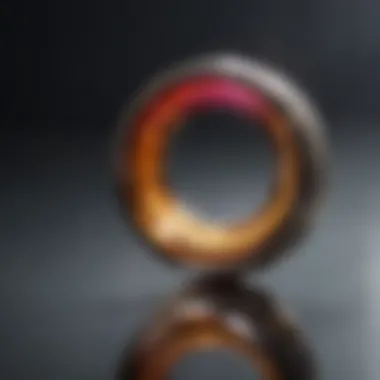
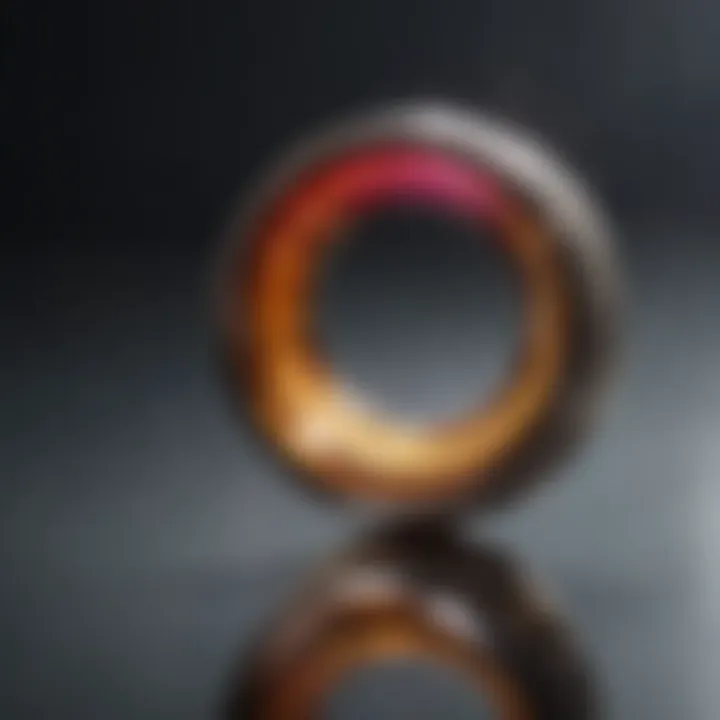
Challenges in Refractometry
In the intricate world of gemology, refractometry plays a crucial role in discerning the qualities of gemstones. However, navigating the realm of refractometers isn't without its hurdles. The limitations of current refractometers and common measurement errors pose significant challenges that can affect gemstone identification accuracy. This section delves into these challenges, presenting a comprehensive overview that sheds light on critical considerations for gem enthusiasts, collectors, and professionals in the jewelry industry.
Limitations of Current Refractometers
Refractometers vary widely in design and functionality, yet they all share some inherent limitations. These constraints can diminish the device's effectiveness in certain situations. Some key limitations include:
- Scope of Measurement: Many refractometers are designed for specific types of gems, meaning they may not perform well across a diverse range of materials. For instance, a standard refractometer might struggle with measuring high-index or heavily included stones.
- Environmental Influences: Factors like temperature and the presence of impurities can cause fluctuations in refractive readings. Such environmental conditions must be carefully managed to ensure accurate results.
- User Proficiency: The effectiveness of refractometry often hinges on the operator's skill. An inexperienced user might misinterpret the readings or improperly calibrate the device, leading to inconsistent data.
Ultimately, while refractometers are invaluable tools, their limitations necessitate a nuanced understanding of when and how to use them effectively.
Common Measurement Errors
Even the best refractometers can falter, especially when measuring gemstones. Understanding potential sources of error is vital for anyone in this field. Here are some common pitfalls:
- Calibration Errors: If the refractometer isn’t calibrated correctly before testing, the resulting readings can be skewed. Regular calibration is essential for maintaining accuracy.
- Sample Preparation: The way a gemstone is prepared for measurement can impact results. For example, dirty or improperly cleaned samples may yield inaccurate readings since surface contaminants can alter the refractive results.
- Inconsistent Pressure: When applying pressure to a gemstone in the refractometer, inconsistency can lead to erratic readings. It’s crucial to maintain even pressure across measurements.
- Misaligned Polarizer: In digital or advanced models, a misaligned polarizer can yield flawed readings. Ensuring that the device components are properly aligned is a critical step often overlooked.
- Light Source Variability: Variations in light sources can change how a gemstone interacts with light. Different light temperatures or intensities can result in substantial differences in refractive index readings.
"The harmony of art and science in gemology reveals itself most profoundly through the lens of refractometry. Understanding its challenges is a pathway to mastery."
In sum, the challenges inherent in refractometry highlight the need for careful handling and understanding of the devices at play. By recognizing these limitations and measurement errors, gemstone enthusiasts and professionals alike can work towards more accurate and reliable evaluations.
Future Innovations in Refractometry
The realm of gemology is constantly evolving, and with it comes the potential for significant advancements in refractometry. The importance of future innovations cannot be overstated, as they promise to enhance both the accuracy and precision of gemstone evaluation. As gem enthusiasts and professionals alike look to better understand and value gems, keeping an eye on emerging technologies becomes essential for effective decision-making in the market. Innovations tend to address current limitations, refine existing tools, and ease the use of refractometers in both professional and amateur settings.
Emerging Technologies
One cannot ignore the strides being made in various technologies that could transform refractometry. Among these, spectral refractometry is a front-runner. This technology utilizes the prism effect of light in combination with spectroscopic techniques to provide detailed insights into the refractive index. For instance, researchers are experimenting with high-resolution spectrometers that quantitatively analyze gemstones in ways traditional refractometers cannot. By analyzing how different wavelengths of light react with a stone, it becomes easier to identify not just the type of gem, but also its precise properties.
In addition, advancements in miniaturization of devices are making portable refractometers more accurate and user-friendly. This opens the flood gates for hobbyists to effectively engage with gemology, as they can carry sophisticated equipment right in their pockets. Innovations in mobile apps interconnected with these devices are also gaining footing, offering instant access to databases containing gemstone information, which enhances the educational experience.
"The beauty of technology is not just in the innovations it brings, but in the democratization of knowledge it enables."
Potential for Improved Accuracy
As with any scientific pursuit, accuracy is paramount. The potential for improved accuracy hinges on several factors. First, the integration of machine learning algorithms could revolutionize how we measure and interpret refractive indices. These algorithms can analyze vast data sets and find patterns that may indicate measurement inaccuracies. By continuously learning from new data, they can identify anomalies and suggest corrections, ultimately leading to more consistent and accurate readings.
Moreover, algorithms can assist in real-time adjustments during measurements. For example, under varying external conditions such as temperature and light, these systems could recalibrate automatically, ensuring that readings align with the conditions that exist at the moment of measurement. This adaptation would be particularly useful when dealing with precious gems, where the stakes are high, and even minor deviations can lead to significant misjudgments.
New materials and technologies can also facilitate better optics in refractometers. Consider the development of advanced coatings for lenses that minimize light loss and distortion. These innovations can bolster the effectiveness of both digital and traditional refractometers, providing clearer and more reliable results.
In summary, the future holds a wealth of potential for refractometry in gemology. By embracing emerging technologies and focusing on enhanced accuracy, we can not only elevate the standards of gem evaluation but also enrich our understanding of these beautiful natural wonders.
Practical Considerations for Gem Enthusiasts
When it comes to gemology, the refractometer index plays a pivotal role in identifying and valuing gems. However, for gem enthusiasts, it's not just the knowledge that counts; it's also about making informed choices. Understanding practical considerations can set the stage for successful gem evaluations and enrich the overall experience of gem collecting and appreciation. Buying a refractometer or engaging in its use without some forethought may be like jumping into the deep end without knowing how to swim—all enthusiasm, but perhaps not enough preparation.
Choosing the Right Refractometer
Selecting the appropriate refractometer can severely affect the quality and accuracy of your gemstone analyses. Here are some elements to consider when making your choice:
- Type of Refractometer: As discussed earlier, there are standard, digital, and portable refractometers. Standard models may be simpler but require more manual effort. Digital units provide quicker and often more accurate readings. Portable refractometers can be convenient for on-the-go evaluation but may sacrifice some accuracy. Think about how and where you'll use it most.
- Calibration and Accuracy: The reliability of your measurements depends significantly on the instrument's calibration. Look for models that allow you to calibrate them easily with known standards. This ensures you are always measuring gemstones with precision.
- Budget: While it's tempting to go for the latest and most expensive model, remember that even budget-friendly options can deliver satisfactory results for beginners. You don't have to empty your pockets right away. Start with a decent refractometer, and as your passion grows, consider upgrading.
- Ease of Use: Some refractometers have steep learning curves. It’s essential to choose a device that suits your skill level. If you’re a newbie, it might be wise to go for a model that's user-friendly with adequate instructional materials available.
Maintenance and Care
Maintaining your refractometer is crucial for ensuring longevity and consistent performance. Think of it as caring for a vintage car—success hinges on regular upkeep. Here are some tips for effective maintenance:
- Regular Cleaning: After each use, make it a habit to clean the prism and the glass surfaces. Your readings can be thrown off by small smudges or residues. Use a soft, lint-free cloth and gentle cleaning solutions designed for optics.
- Storage Considerations: When not in use, store your refractometer in a case to protect it from dust, dirt, and accidental damage. Ideally, the storage environment should be stable in terms of temperature and humidity.
- Routine Calibration: Just like a musician regularly tunes their instrument, you should periodically calibrate your refractometer. This practice helps maintain accuracy and integrity over time.
- Read the Manual: Don’t underestimate the value of the manufacturer's guide. Each device has unique requirements and quirks. Following the specific recommendations can enhance the performance of your refractometer.
"Consistency is key in gemology; each step taken with care leads to truths unveiled beneath the sparkle!"
By focusing on these practical considerations, gem enthusiasts can elevate their gemstone evaluation processes. It's not simply about having the right tools; it's about using them wisely and responsibly. Whether you are a seasoned gemologist or just starting, these elements can enrich your journey into the fascinating realm of gemology.
Culmination
In wrapping up our exploration of refractometry in gemology, it becomes clear that this subject isn't just a niche fascination for gemologists but holds pivotal importance for anyone passionate about gemstones. Understanding the refractive index equips enthusiasts, collectors, jewelry designers, and geology aficionados with critical insights necessary for evaluating and appreciating these natural wonders.
Summary of Key Points
- Fundamental Principles: The refractive index plays a central role in light refraction, which is essential for gemstone identification and evaluation.
- Variety of Refractometers: There are diverse types of refractometers—standard, digital, and portable—each suited for different settings and user needs, ensuring versatility in application.
- Measurement Process: Accurate measurement is vital, requiring proper calibration and understanding of the methods involved in obtaining the refractive index.
- Market Implications: Awareness of how refractive index influences gemstone value is crucial, as market trends often hinge on these scientific measurements.
- Future Innovations: As technology evolves, we can expect more precise tools that could enhance our understanding of gemstones, potentially affecting both evaluation methods and the market.
The Significance of Refractometry in Gemology
Refractometry stands as a cornerstone of gemological practice, balancing art and science. By helping gemologists distinguish between similar-looking stones and ascertain their quality, refractometry not only aids in identification but also plays a substantial role in determining the worth of gems. A gemstone's refractive index can reveal its unique properties, guiding buyers and sellers alike. Furthermore, as new treatments and synthetics enter the market, the ability to accurately measure and interpret refractive indices is crucial for maintaining integrity in the gemstone industry. Ultimately, the integration of refractometry into gemology provides an essential framework for understanding, valuing, and appreciating the beauty encapsulated in these natural treasures.



